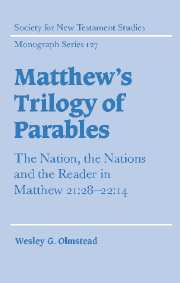Book contents
- Frontmatter
- Contents
- Acknowledgements
- Part one Prolegomena
- Part two The trilogy in narrative-critical perspective
- Part three The trilogy in redaction-critical perspective
- 6 The trilogy in redaction-critical perspective
- 7 Conclusions
- Appendix The text of the parable of The Two Sons
- Notes
- Bibliography
- Index of passages
- Index of selected topics and modern authors
7 - Conclusions
Published online by Cambridge University Press: 22 September 2009
- Frontmatter
- Contents
- Acknowledgements
- Part one Prolegomena
- Part two The trilogy in narrative-critical perspective
- Part three The trilogy in redaction-critical perspective
- 6 The trilogy in redaction-critical perspective
- 7 Conclusions
- Appendix The text of the parable of The Two Sons
- Notes
- Bibliography
- Index of passages
- Index of selected topics and modern authors
Summary
Method
This study has attempted to demonstrate the validity of the proposal that redaction- and narrative-critical approaches to the Gospels can function as effective allies in addressing the intended meaning of the Gospel narratives and the responses they elicited from their first readers.
Narrative critics have distanced themselves from redaction critics in several ways. At two important points, I have defended a mediating position. First, whereas redaction criticism has typically been a cognitive, author-oriented discipline, and narrative criticism has focused on the text and its affective impact on the reader, I have argued that careful attention to the author and the reader (or to the cognitive and the affective domains) are not mutually exclusive. Following the lead of speech-act theorists, I have suggested that, in addition to propositional content, speech-acts – whether verbal or written – have both illocutionary and perlocutionary force. On this model of communication, questions may be posed about both the intended meaning and the intended function of written texts – questions embracing both author and reader, both what a text means and what it does. Accordingly, this study has repeatedly returned to one question: ‘What does the text suggest that the evangelist intended to elicit from his readers by way of response?’
Second, narrative critics have typically denounced the fragmentation of the Gospel narratives that is too often the accompaniment of redaction criticism, and have instead emphasised – rightly, in my view – the integrity of the Gospel narratives.
- Type
- Chapter
- Information
- Matthew's Trilogy of ParablesThe Nation, the Nations and the Reader in Matthew 21:28-22:14, pp. 160 - 166Publisher: Cambridge University PressPrint publication year: 2003



